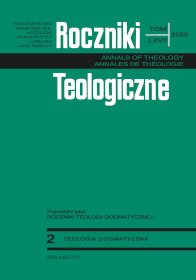John Paul II’s Pneumatology of the Nations
Abstract
How to define nations’ pneumatology in the light of John Paul II teaching? Is the action of the Holy Spirit among the nation single and select or is it a part of the Mystery of Salvation and widespread activity in the Church? The answers to these questions can be found in the John Paul’s speeches and homilies made during his first pilgrimage to Poland and his first encyclic “Redemptor hominis”. There are presented the origins of the definition of nations’ pneumatology which is the Second Vatical Council. It calls for analyzing and explaining signs of the times in the light of Gospel. It was the Council which stressed the importance of interest in the Holy Spirit activity in social development and in the course of human history. These are actually the fields where we can find the bases of nations’ pneumatology and the observation of the Holy Spirit in the history of nations. John Paul II addresses these issues from the first days of his papacy. He points out that the Church originated in the Cenacle and through the Church people and nations are allowed to Mystical Body of Jesus Christ. All the subsequent gestures and symbols presented in the baptism of individual nations are just the answer to the most important act – the Pentecost.
References
Bazyli Wielki, O Duchu Świętym, tł. A. Brzóstowska, Warszawa 1999.
Urs von Balthasar H., Sobór Ducha Świętego: apostolska wizja Kościoła, w: L. Balter (red.), Duch Odnowiciel, Poznań 1998, s. 167-182.
Bartnik Cz., Duch Święty a hamartologia, w: Jan Paweł II, Dominum et Vivificantem. Tekst i komentarze, Lublin 1994, s. 161-171.
Czaja A., Kościół jako komunia w Duchu Świętym: Koncepcja kardynała Józefa Ratzingera, w: J. Cichoń (red.), Ratio et revelatio. Z refleksji filozoficzno-teologicznych. Księga pamiątkowa dedykowana Księdzu Profesorowi Józefowi Herbutowi z okazji 65. rocznicy urodzin, Opole 1998, s. 351-368.
Czaja A., Credo in spiritum vivificantem: Pneumatologiczna interpretacja Kościoła jako komunii w posoborowej teologii niemieckiej, Lublin 2003.
Congar Y., Wierzę w Ducha Świętego, t. II, tł. L. Rutowska, Warszawa 1995.
Dalbesio A., Duch Święty w Nowym Testamencie, w Kościele, w życiu chrześcijańskim, Kraków 2001.
Dagens C., Duch Święty, Krzyż Chrystusa a historia ludzi, „Communio”, 8(1988), nr 1, s. 61-75.
Hryniewicz W., „Duchowi Świętemu Pan powierzył człowieka”: Rozważania o doświadczeniu Ducha Świętego w chrześcijaństwie wschodnim, w: A.L. Szafrański (red.), Dominum et vivificantem. Tekst i komentarze, Lublin 1999, s. 261-286.
Jakubowski M., Nowe dary Ducha Świętego dla Polski, „W Drodze”, (1994), nr 9, s. 93-98.
Napiórkowski C., Działanie Ducha Świętego w Kościele, „Wiadomości Diecezjalne Siedleckie”, 66(1997), z. 12, s. 523-534.
Pek K., Trylogia: Wierzę w Ducha Świętego, w: S.C. Napiórkowski, A. Czaja, K. Pek (red.), Yves Congar 1904-1995, Lublin, 1998, s. 77-83.
Warzeszak J., Działanie Ducha Świętego w świecie i w Kościele według średniowiecznej szkoły franciszkańskiej, Niepokalanów 1992.
Warzeszak J., Pneumatologia współczesna, Warszawa 2009.
Copyright (c) 2020 Roczniki Teologiczne

This work is licensed under a Creative Commons Attribution-NonCommercial-NoDerivatives 4.0 International License.





